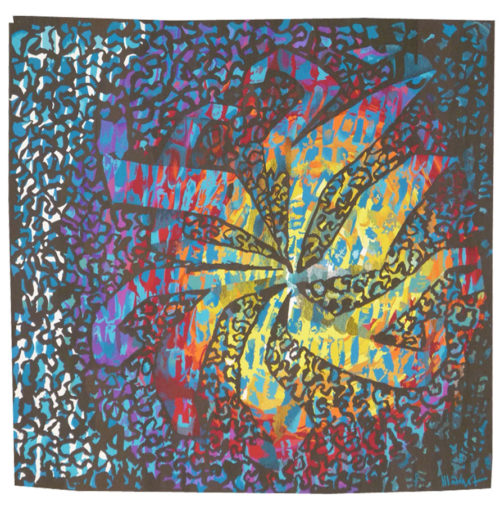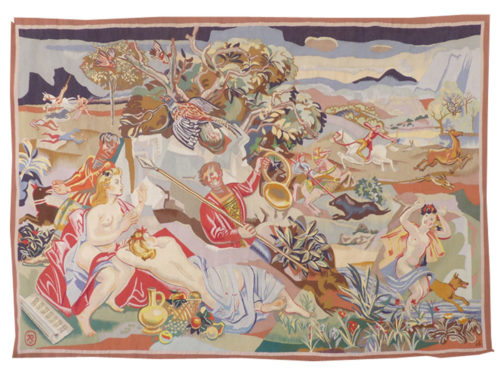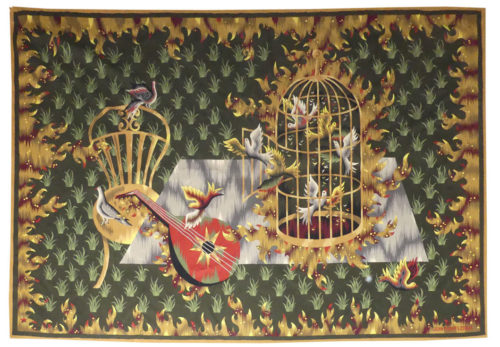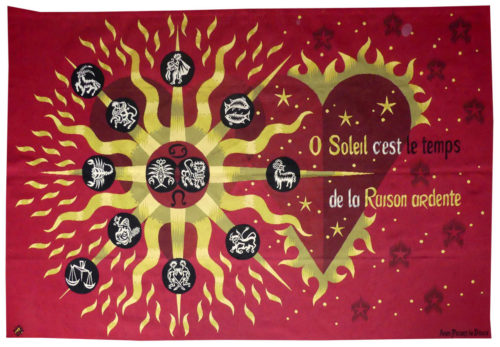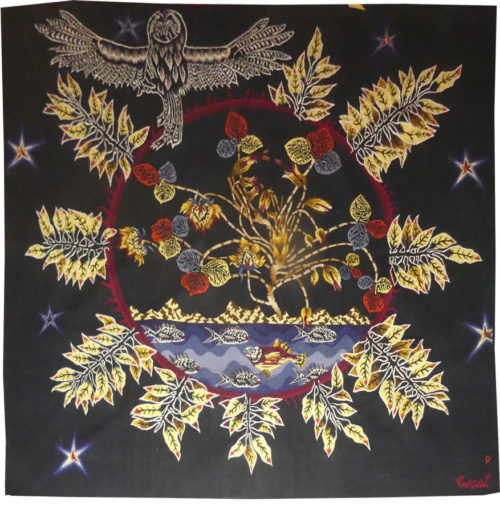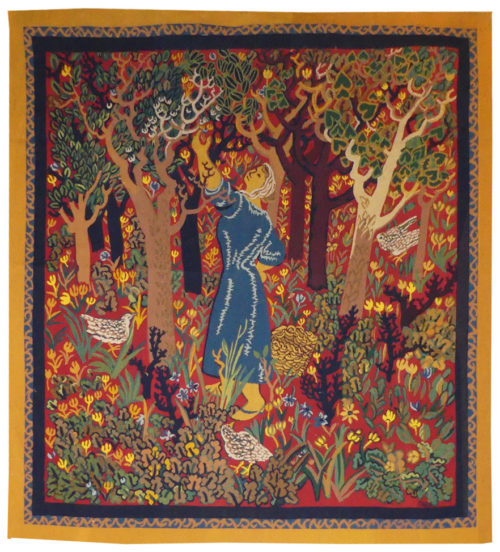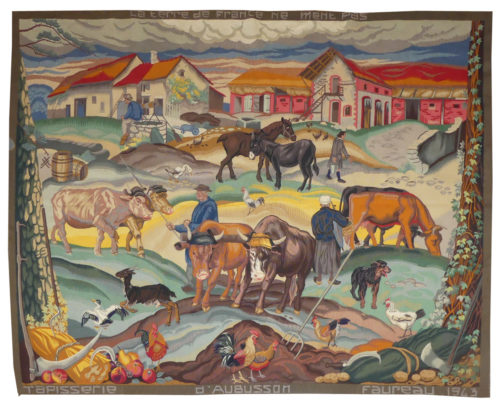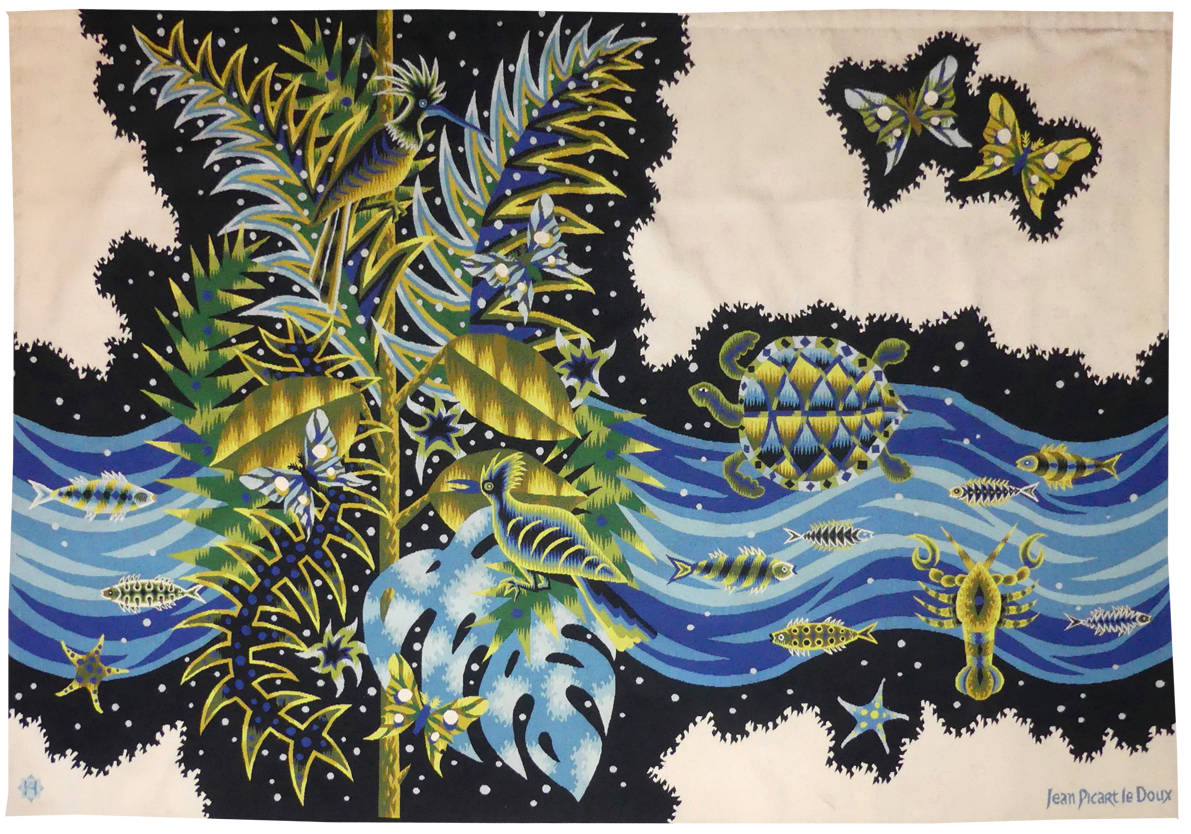-
Nymphes et chasseurs (Nymphs and hunters)
Aubusson tapestry woven in the Pinton workshop for the Compagnie des Arts Français. 1941. The place occupied by André Planson in the history of tapestry-making is a direct result of the role that was alotted to him by Jacques Adnet in the synthesis of art and design advocated by the Compagnie des Arts Français of which he was the director. As early as 1941, Adnet approached several painters (Brianchon, Vera,... and Planson) to design tapestry cartoons in the context of furniture and interior design : “our intention was to demonstrate that contemporary tapestries have much to contribute to the integrated design of a room” (L. Chéronnet, Jacques Adnet, Art et Industrie 1948). The Compagnie des Arts Français organised throughout the 1940’s tapestry exhibitions on its premises. These ambitious decorative aspirations, which were important in encouraging the renewal of the art of the tapestry, remain however somewhat irrelevant to the preoccupations of Lurçat and his followers. The gracious and joyful attributes (compare with the contemporary creations of Lurçat or Gromaire) of the Compagnie are plainly evident in this cartoon dating from 1941 which brings right up to date the traditional tapestry themes of the hunting scene and bucolic pleasures in a voluntarily innovative style which is highly decorative. Although certain technical innovations typical of the Lurçat doctrine are already assimilated (limited palette, irregular stitch size) it is to be noted that this decorative intention is still influenced by techniques associated with painting (the use of perspective, and shading for flesh colours...) -
Les oiseaux s'envolent (birds fly)
Aubusson tapestry woven in the Berthaut workshop. Complete with certificate of origin signed by the artist. 1949. Jean Picart le Doux is one of the foremost figures in the renaissance of the art of tapestry. His earliest contributions to the field date back to 1943 when he designed cartoons for the passenger ship “la Marseillaise”. A close associate of Lurçat, whose theories he would adopt (limited palette, numbered cartoons…), he was a founding member of the A.P.C.T. (Association des Peintres-cartonniers de Tapisserie), and soon after, a teacher at the Ecole Nationale Supérieure des Arts Décoratifs. The state gave him several commissions most of them at the Aubusson workshop, and some at the Gobelins : the most spectacular of these being for the University of Caen, the Theatre in Le Mans, the passenger ship France or the Prefecture of the Creuse département … In as much as Picart le Doux’s aesthetic is close to that of Lurçat, so also is his inspiration and his subject matter, although in a register which is more decorative than symbolic, where he brings together heavenly bodies (the sun, the moon, the stars…), the elements, nature (wheat, vines, fish, birds…), man, literary quotation … “Les oiseaux s’envolent” (the flight of the birds) was intended as a symbolic representation of the Liberation of France, a theme which recurrs in the “la cage ouverte’ (the open cage) in 1953. Bibliography : Maurice Bruzeau, Jean Picart le Doux, Murs de soleil, Editions Cercle d’art, 1972 Exhibition Catalogue, Jean Picart le Doux, tapisseries, Musée de Saint-Denis, 1976 Exhibition Catalogue Jean Picart le Doux, Musée de la Poste, 1980 -
Ô soleil (O Sun)
Aubusson tapestry woven by the Hamot workshop. With signed label, n°2/8. 1968. Jean Picart le Doux is one of the foremost figures in the renaissance of the art of tapestry. His earliest contributions to the field date back to 1943 when he designed cartoons for the passenger ship “la Marseillaise”. A close associate of Lurçat, whose theories he would adopt (limited palette, numbered cartoons...), he was a founding member of the A.P.C.T. (Association des Peintres-cartonniers de Tapisserie), and soon after, a teacher at the Ecole Nationale Supérieure des Arts Décoratifs. The state gave him several commissions most of them at the Aubusson workshop, and some at the Gobelins : the most spectacular of these being for the University of Caen, the Theatre in Le Mans, the passenger ship France or the Prefecture of the Creuse département ... In as much as Picart le Doux’s aesthetic is close to that of Lurçat, so also is his inspiration and his subject matter, although in a register which is more decorative than symbolic, where he brings together heavenly bodies (the sun, the moon, the stars...), the elements, nature (wheat, vines, fish, birds...), man, literary quotation ... « The inclusion of text constitutes a closer means of communication with the poet” says Picart le Doux (a process used also by Lurçat) who will quote Apollinaire as here (“la jolie rousse”) but also Whitman, Eluard, Saint John Perse,... Illustrated by an ardent heart and, in a literal reflection of the text, by the sun, he associates the zodiac, one of his recurrent motifs, with the love poem. Bibliography : Maurice Bruzeau, Jean Picart le Doux, Murs de soleil, Editions Cercle d’art, 1972, ill. n°161 Exhibition Catalogue, Jean Picart le Doux, tapisseries, Musée de Saint-Denis, 1976 Exhibition Catalogue Jean Picart le Doux, Musée de la Poste, 1980 -
Lurçat’s artistic production was immense : it is however his role as the renovator of the art of tapestry design which ensures his lasting renown. As early as 1917, he started producing works on canvas, then in the 20’s and 30’s, he worked with Marie Cuttoli. His first collaboration with the Gobelins workshop dates back to 1937, at the same time he discovered the tapestry of the Apocalypse which was essential in his decision to devote himself to tapestry design. He first tackled the technical aspects with François Tabard, then on his installation at Aubusson during the war, he established his technique : broad point, a simplified palette, outlined cartoons with colours indicated by pre-ordained numbers. A huge production then follows (over 1000 cartoons) amplified by his desire to include his painter friends, the creation of the A.P.C.T. (Association des Peintres-Cartonniers de Tapisserie) and the collaboration with the art gallery La Demeure and Denise Majorel, and then by his role as a tireless advocate for the medium around the world. His tapestries reveal a pictorial world which is specifically decorative, with a very personal symbolic iconography : cosmogony (the sun, the planets, the zodiac, the four elements…) stylised vegetation, fauna (rams, cocks, butterflies, chimera …) standing out against a background without perspective (voluntarily different from painting) and, in his more ambitious work, designed as an invitation to share in a poetic (he sometimes weaves quotations into his tapestries) and philosophical (the grand themes are broached from the wartime period onwards) vision whose climax is the “Chant du Monde” (Song of the World) (Jean Lurçat Museum , ancien hôpital Saint Jean, Angers) which remained unfinished at his death. As is often the case, the title makes a reference to Latin America. As for the circular motif accompanying the owl, it is a classic as in, for example, “Forêt bleue” or “La chouette des figuiers”,... Bibliography : Tapisseries de Jean Lurçat 1939-1957, Pierre Vorms Editeur, 1957 Exhibition Catalogue Lurçat, 10 ans après, Musée d’Art moderne de la ville de Paris, 1976 Exhibition catalogue Les domaines de Jean Lurçat, Angers, Musée Jean Lurçat et de la tapisserie contemporaine, 1986 Symposium Jean Lurçat et la renaissance de la tapisserie in Aubusson, Aubusson, Musée départemental de la tapisserie 1992 Exhibition Catalogue Dialogues avec Lurçat, Musées de Basse-Normandie, 1992 Exhibition catalogue Jean Lurçat, Donation Simone Lurçat, Académie des Beaux-Arts, 2004 Jean Lurçat, le chant du monde Angers 2007 Gérard Denizeau, Jean Lurçat, Liénart, 2013 Exhibition Catalogue Jean Lurçat, Meister der französischen Moderne, Halle, Kunsthalle, 2016 Exhibition Catalogue Jean Lurçat au seul bruit du soleil, Paris, galerie des Gobelins, 2016Aubusson tapestry woven in the Pinton workshop. With signed label. Circa 1955.
-
La cueillette (Harvest)
Tapestry. 1943. Artiste polyvalent (graveur, médailleur, céramiste, fresquiste…), Savin est sollicité pendant la guerre par Guillaume Janneau, qui admire la monumentalité intemporelle et réaliste de son esthétique (et dont il soupçonnait qu’elle n’aurait nul besoin de transposition pour convenir à la Tapisserie), pour concevoir des cartons pour les Manufactures Nationales : « les plaisirs et les travaux champêtres » ( 4 cartons), puis les « 12 mois de l’année » sont créés simultanément à son travail avec la Compagnie des Arts Français. L’influence des aspects techniques de la tapisserie médiévale est très prégnante chez l’artiste, attentif aux colorants naturels en gamme réduite, aux formes simples permises par la technique du gros point,… Il fut l’un des artistes les plus représentés à l’exposition séminale de 1946, avec 7 pièces (seuls Lurçat, Saint-Saëns et Gromaire en eurent plus). « La cueillette » est contemporaine du carton conçu pour les Gobelins : « La cueillette des pommes », issue de la tenture sur « les plaisirs et travaux champêtres ». On y trouve les mêmes caractéristiques propres à l’artiste : gamme chromatique limitée mais vive, formes simplifiées et monumentales, densité de la composition, et une saveur rustique tout droit venue de la tapisserie médiévale. Bibliographie : Cat. Expo. La tapisserie française du Moyen-âge à nos jours, Paris, Musée d’art moderne, 1946 Cat. Expo. Le Mobilier National et les Manufactures Nationales sous la IVe République, Beauvais, Galerie nationale de la Tapisserie, 1997 Cat. Expo. La Manufacture des Gobelins dans la 1ère moitié du XXe siècle, Beauvais, Galerie nationale de la Tapisserie, 1999 -
La terre de France ne ment pas (French soil doesn't lie)
François Faureau is a singular figure. Born in Aubusson, he studied at the ENAD, of which at the time the director was Marius Martin who was already promoting the use of thick yarn and counted colours that Lurçat would later adopt. Thus he was a representative of the peintre-cartonniers at the stand of the ENAD at the Exposition internationale des Arts décoratifs in 1925 with his tapestry “Solitude, verdure” or the screen “Canards”, which hesitate between neo-classicism and the influence of cubism. He later founded his own workshop, but his production remained somewhat confidential, and somewhat removed from the protagonists of the “Tapestry Renaissance”. Although the workshops in Aubusson continued their activity during the occupation (as did the Manufactures Nationales), the production of pieces directly influenced by the imposition of the values of Pétain’s government are rare, despite the fact that this typically traditional skill undoubtedly coincided with the values of what was known at the time as the National Revolution. The famous formula spoken by Maréchal Pétain on 25th June 1940 (although its author was Emmanuel Berl), which went on to become a leitmotiv in the official public discourse, exalting the countryside, society’s peasant roots and, rather more prosaically, agriculture, is illustrated here in a very literal fashion bringing together the various rural tasks, vegetation, architecture and animals... all harmoniously exposed under the protective watch of the Vichy regime. Provenance : Collection Régine Deforges Bibliography : Exhibition catalogue Tapisseries 1925, Aubusson, Cité de la tapisserie, 2012Aubusson tapestry. 1943. -
Amazonie (Amazonia)
Aubusson tapestry woven by the Hamot workshop. With signed label. 1962. Jean Picart le Doux is one of the foremost figures in the renaissance of the art of tapestry. His earliest contributions to the field date back to 1943 when he designed cartoons for the passenger ship “la Marseillaise”. A close associate of Lurçat, whose theories he would adopt (limited palette, numbered cartoons...), he was a founding member of the A.P.C.T. (Association des Peintres-cartonniers de Tapisserie), and soon after, a teacher at the Ecole Nationale Supérieure des Arts Décoratifs. The state gave him several commissions most of them at the Aubusson workshop, and some at the Gobelins : the most spectacular of these being for the University of Caen, the Theatre in Le Mans, the passenger ship France or the Prefecture of the Creuse département ... In as much as Picart le Doux’s aesthetic is close to that of Lurçat, so also is his inspiration and his subject matter, although in a register which is more decorative than symbolic, where he brings together heavenly bodies (the sun, the moon, the stars...), the elements, nature (wheat, vines, fish, birds...), man, literary quotation ... Since « Orénoque » dating from 1956 (Bruzeau n°72), South America recurrs regularly in the work of Picart le Doux. Here “la huppe”, a vertical cartoon (Bruzeau n°97) is enlarged horizontally by the addition of the river peopled with turtles, fish ...in a highly effective decorative ensemble. Bibliography : Marthe Belle-Jouffray, Jean Picart le Doux, Publications filmées d’art et d’histoire, 1966, ill. n°5 Maurice Bruzeau, Jean Picart le Doux, Murs de soleil, Editions Cercle d’art, 1972, ill. n°129 Exhibition Catalogue, Jean Picart le Doux, tapisseries, Musée de Saint-Denis, 1976 Exhibition Catalogue Jean Picart le Doux, Musée de la Poste, 1980, n°14 ill.


